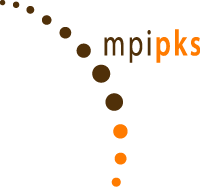
Strong correlations and angle-resolved photoemission
Workshop Report
The workshop CORPES25 took place June 02 - 06, 2025, at the MPI-PKS. The aim of the biannual CORPES forum, existing since 2005, is to foster exchange at the cross-roads of two broad areas: Many-body electronic structure theory and angle-resolved photoemission spectroscopy (ARPES). In between events, it is upheld by an international program committee. This continuity was symbolized by the fact that the first talk in the opening session was given by Xingjiang Zhou, the chairman of CORPES23 in Beijing, China, and an invitation to Kalkota, India, was extended in the closing session by Kalobaran Maiti, the designated chairman of CORPES27.
The MPI-PKS played a decisive role in launching the CORPES forum by hosting the first two events, CORPES05/07, setting correlations in “High-Tc” and “Heavy fermions” as hot topics at the time. The key ideas how to structure a workshop, in order to create a prevailing spirit of cooperation and scientific cohesion in the CORPES meetings go back to Peter Fulde, who sadly passed away about a year ago.
An excellent work environment, also including room and board for all participants, an excursion to Meissen and a banquet, was provided thanks to the MPI-PKS visitor program, under the competent and friendly coordination of Kristina Aliabiev. The workshop was also sponsored by the IFW, Dresden.
Contributions of 94 participants from 18 countries were structured in 24 invited and 23 contributed talks, as well as 47 posters. Tuesday and Thursday evening, discussion sessions were organized in the poster area, preceded by short oral presentations in the “poster flash” sessions. Abstracts of all talks and posters can be consulted on the web page, permanently hosted by the MPI-PKS.
Two oral sessions each were dedicated to “High Tc”, “Topology” and “Tr-ARPES”; one session each to “Orbital effects”, “Heavy fermions”, “Polaron and el-ph” and “Related spectroscopies”. Typically, whether in theory or experiment, most contributions could not really be labelled by a single topical heading. The reported progress in established fields of correlated materials describing the low energy electronic structure is notably based on novel instrumentation like laser ARPES, spin- and momentum microscopy, measuring dichroism, theoretical treatment in DFT+DFMT as well as tailored multilayer sample designs or combination of ARPES with RIXS or STM. They also serve as roots for novel developments. Thus, optical control schemes in “Tr-ARPES” open the field to stimulation of population inversion or light-induced superconductivity, as well as selective control of topology.
In “Topology”, a drive towards possible applications could be felt: How to use ARPES to rapidly identify topologically protected states in novel materials and how to stabilize them in ambient conditions. Beyond the colloquium talk, given by Ralph Claessen, this was evident in many excellent contributions, also from representatives of the photon sources. The classification of topological states in non-crystalline or strongly correlated materials was also debated.
“Topology”, “Tr-ARPES” and “Orbital effects” are now represented with increasing impact in the CORPES forum. Beyond a number of confirmed leaders as invited speakers, the rising dynamics was most strikingly illustrated by unsolicited high-quality proposals, sent in by other confirmed leaders and principal investigators, as well as numerous post docs and PhD students. For the poster awards, the contributions of Sarath Sasi and Marieke Visscher were selected by the international program committee.
An overriding theme for all topics, including “Related spectroscopies” such as STM/STS, RIXS or EELS, is the need for an improved modelling of the coupling between light and matter, taking into account the characteristics of the photon beam and material- or even layer-specific Wannier orbitals for the matrix elements.
